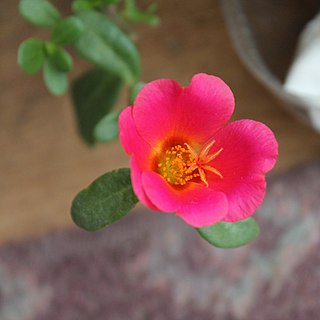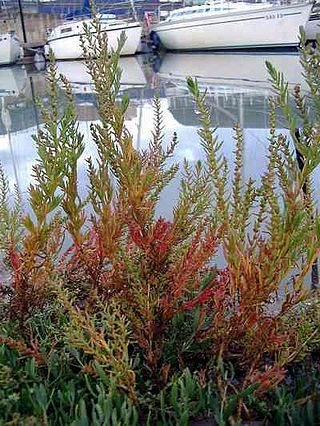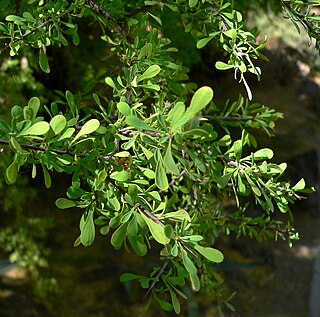
Phytolacca is a genus of perennial plants native to North America, South America and East Asia. Some members of the genus are known as pokeweeds or similar names such as pokebush, pokeberry, pokeroot or poke sallet. Other names for species of Phytolacca include inkberry and ombú. The generic name is derived from the Greek word φυτόν (phyton), meaning "plant," and the Latin word lacca, a red dye. Phytolaccatoxin and phytolaccigenin are present in many species which are poisonous to mammals if not prepared properly. The berries are eaten by birds, which are not affected by the toxin. The small seeds with very hard outer shells remain intact in the digestive system and are eliminated whole.

The Rhamnaceae are a large family of flowering plants, mostly trees, shrubs, and some vines, commonly called the buckthorn family. Rhamnaceae is included in the order Rosales.

Nolina is a genus of tropical xerophytic flowering plants, with the principal distribution being in Mexico and extending into the southern United States. They are large, dioecious plants.

Portulaca is a genus of flowering plants in the family Portulacaceae, and is the type genus of the family. With over 100 species, it is found in the tropics and warm temperate regions. Portulacas are also known as the purslanes.

Alphitonia is a genus of arborescent flowering plants comprising about 20 species, constituting part of the buckthorn family (Rhamnaceae). They occur in tropical regions of Southeast Asia, Oceania and Polynesia. These are large trees or shrubs. In Australia, they are often called "ash trees" or "sarsaparilla trees". This is rather misleading however; among the flowering plants, Alphitonia is not closely related to the true ash trees, and barely at all to the monocot sarsaparilla vines (Smilax).

Pomaderris is a genus of about 80 species of flowering plants in the family Rhamnaceae, the species native to Australia and/or New Zealand. Plants in the genus Pomaderris are usually shrubs, sometimes small trees with simple leaves arranged alternately along the branches and bisexual, woolly-hairy flowers arranged in racemes or panicles. The flowers are usually yellow and often lack petals.

Hackelia (stickseeds) is a genus of plants in the borage family, Boraginaceae. It includes 54 species found in North America, western South America, temperate Eurasia, and Australia. 12 species are native to California.

Colubrina elliptica, also known as mabi or soldierwood, is a species of flowering tree in the family Rhamnaceae that is native to the Florida Keys, the Caribbean, Central America, Mexico, and Venezuela.

Ericameria nauseosa, commonly known as chamisa, rubber rabbitbrush, and gray rabbitbrush, is a shrub in the sunflower family (Aster) found in the arid regions of western North America.

Suaeda is a genus of plants also known as seepweeds and sea-blites. Most species are confined to saline or alkaline soil habitats, such as coastal salt-flats and tidal wetlands. Many species have thick, succulent leaves, a characteristic seen in various plant genera that thrive in salty habitats.

Condalia is a genus of spiny shrubs in the tribe Rhamneae of the buckthorn family, Rhamnaceae. It was named for Antonio Condal, an 18th century Spanish physician. Members of the genus are native to tropical and subtropical deserts and xeric shrublands in North and South America. The ranges of each species vary considerably; some are confined to only a few square miles, while others can be found on an area up to 1,000 sq mi (2,600 km2).

Tithonia is a genus of flowering plants in the tribe Heliantheae within the family Asteraceae.

Colubrina californica, also known as Las Animas nakedwood, is a species of shrub in the family Rhamnaceae.

Piscidia is a genus of flowering plants in subfamily Faboideae of the family Fabaceae. It includes seven species of trees, and rarely shrubs, native to the tropical Americas, ranging from northern Mexico and Florida through Central America and the Caribbean to Venezuela and Peru. Typical habitats include seasonally-dry tropical forest, woodland, and bushland, often on rocky hills, with some species restricted to limestone substrates.

Melanthera, is a genus of perennial flowering plants in the family Asteraceae, native to North and South America, as well as Africa, Asia and Oceania, including Hawaiʻi.

Colubrina asiatica is a shrub in the family Rhamnaceae that is native to tropical and subtropical regions of the Old World, from eastern Africa to India, southeast Asia, tropical Australia, and the Pacific Islands. Common names include latherleaf, Asian nakedwood and Asian snakewood.
Colubrina greggii, commonly known as Sierra nakedwood or Gregg's colubrina, is a species of flowering plant in the family Rhamnaceae native to eastern Mexico, with a disjunct population in southern Texas in the United States.

Condalia hookeri, called the Brazilian bluewood, is a widespread species of flowering plant in the family Rhamnaceae, native to Texas and eastern Mexico. It is a thorny shrub or small tree reaching 6 m (20 ft) but usually much shorter. Typically it is found growing in marginal habitats such as limestone slopes, sandstone bluffs, lunettes, shell ridges, juniper-dominated woodlands, or along watercourses, often in clayey or sandy soils, at elevations from 10 to 400 m. It may come to dominate an area as a thorny scrubland.

Colubrina texensis, the Texas snakewood or Texas hog plum, is a species of flowering plant in the family Rhamnaceae, native to Texas and northeastern Mexico. A 3 to 6 ft deciduous shrub with zig-zagging branches and patterned bark, it is typically found growing in dry, poor soils.


















